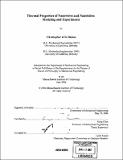Thermal properties of nanowires and nanotubes : modeling and experiments
Author(s)
Dames, Christopher Eric
DownloadFull printable version (24.58Mb)
Other Contributors
Massachusetts Institute of Technology. Dept. of Mechanical Engineering.
Advisor
Gang Chen.
Terms of use
Metadata
Show full item recordAbstract
Nanowires and nanotubes have drawn a great deal of recent attention for such potential applications as lasers, transistors, biosensors, and thermoelectric energy converters. Although the thermal properties of nanowires can differ greatly from their bulk counterparts, the theoretical and experimental understanding of these differences is still limited. Thermal performance is especially important for nanowire thermoelectrics, which are expected to have energy conversion efficiencies far superior to bulk materials. This efficiency increase may lead to a broad range of applications for reliable, solid-state energy conversion, including household refrigeration and waste heat scavenging for power generation. In this thesis, the fundamental thermal properties of nanowires and nanotubes are explored from both theoretical and experimental perspectives. Modeling and experiments on titanium dioxide nanotubes confirm that quantum size effects can cause enhancements in the specific heat at low temperature, while modeling of classical size effects in nanowires and superlattice nanowires shows that the thermal conductivity can be reduced by several orders of magnitude compared to bulk, in agreement with available experimental data. (cont.) To facilitate further experimental studies of individual nanowires, the "3-omega" methods for thermal properties measurements were made more rigorous, simpler to implement, and generalized to 1-omega and 2-omega methods which may be advantageous for nanoscale systems. These methods are used to deduce the thermal properties of a system from its electrical response at the first, second, or third harmonic of a driving current. Finally, a detailed design and preliminary measurements are presented for a new type of hot-wire probe based on Wollaston wire and used to measure the thermoelectric properties of individual nanowires and nanotubes inside a transmission electron microscope.
Description
Thesis (Ph. D.)--Massachusetts Institute of Technology, Dept. of Mechanical Engineering, 2006. Includes bibliographical references.
Date issued
2006Department
Massachusetts Institute of Technology. Department of Mechanical EngineeringPublisher
Massachusetts Institute of Technology
Keywords
Mechanical Engineering.